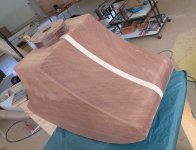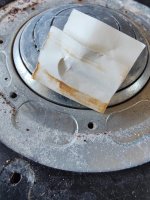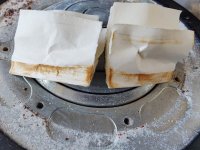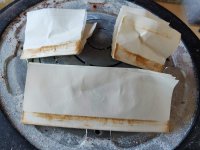A few days ago, I bought a pair of JBL 2447J drivers. The seller refused on showing photos from the inside but promised a “perfect” condition. The whole story can be read here:
https://sphericalhorns.net/2024/07/15/buying-used-compression-drivers-what-condition-is-acceptable/
I have never seen such a bad condition before and would like to ask for any suggestion what to do now? Is there any chance to get these drivers clean again, especially inside the phase plug?
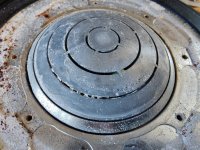

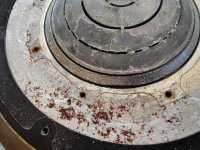
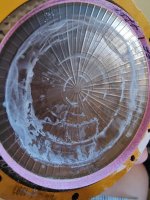
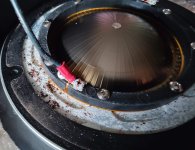
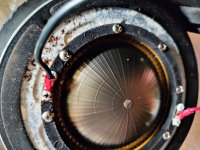
https://sphericalhorns.net/2024/07/15/buying-used-compression-drivers-what-condition-is-acceptable/
I have never seen such a bad condition before and would like to ask for any suggestion what to do now? Is there any chance to get these drivers clean again, especially inside the phase plug?






Last edited:
How did you pay? I would absolutely try to return them. Did you power them up before you popped the caps? He said they were working.
Rob 🙂
Rob 🙂
They produce a kind of sound but the impedance and fr is a quite odd. I have tried to return them but the seller insists they were ok and because I have opened the drivers I have destroyed them. We all know that opening the back cap and replacing the diaphragm is a normal maintenance task. What crude arguments. Personally, I would be ashamed to sell something so disgusting to someone.
So do you see no chance to get them clean again?
So do you see no chance to get them clean again?
It may be possible to clean them if you somehow manage their complete disassembly, like so ...Is there any chance to get these drivers clean again, especially inside the phase plug?
So do you see no chance to get them clean again?
I couldn't say have never had to deal with an issue like that. You might as well try you have nothing to loose. I would clean the gap as recommended when ever you replace the diaphragm. With the phase plug I use a wetted Q-Tip on the plug top to see it is is soluble in a benign solution you can bake out at a low temp on a hotplate. Steam distilled water like you use in a steam iron as an example.
You also may be able to use a light on the horn side looking at the phase plug in a darkened room. You should get fairly even light distribution so any dark areas should show where blockages are. Might want to just try compressed are to blow any loose stuff before you do any "wet work" If the residue is powdery a lot could be removed by simple abrasion with a stiff brush
Here is a cross section of the 476Mg uses the same phase plug as a reference
Good Luck!
Rob 🙂
Attachments
Last edited:
It may be possible to clean them if you somehow manage their complete disassembly, like so ...
View attachment 1333948
They are glued ferrite not like an older alnico you can de-mag and strip down/
Rob 🙂
Looks like beer dumped in the floor wedges, had to refurbish quite a few..I have never seen such a bad condition before and would like to ask for any suggestion what to do now? Is there any chance to get these drivers clean again, especially inside the phase plug?
Suggestions here:
https://forums.prosoundweb.com/index.php/topic,148662.0.html
A water hose with a rubber strip ran around the exit jammed in the throat would probably clear most of the junk out of the phase plug.
Thanks. The other thread suggest using some white vinegar. This reminds me that water heaters randomly need descaling. Definitely not the first attempt and start with less powerful attempts;-)
To my experience the driver suffered water damage (flooding) over an extended time (well above a week before any action was taken), any half-way experienced speaker tech would confirm that and make a bulletproof case in the court alone from the photos.
Anyway. The first attempt to remedy that should be with a hot water stream since it clears most of mud, dust and sugary debris (soda, beer, sugar etc), after that use alcohol (window cleaner, spiritus) which clears off any oil based substances. If that doesn't clear it up, it's advised to clear debris mechanically, You could do that with high pressure washing (it already got extensive water damage, you can't worsen it any more) and in the phase correction element, you can use cardboard strips, moderately thin to medium thickness plastic or since the thickness anc curvature might be vary/change a metal mechanics thickness gauge, which is flexible, precise in thickness (per trait) and you can gouge up if it doesn't clear everything and it follows every bend and curve. Or use the gouged thickness with a matching strip of metal or plastic (if it's at/near the pole plate), possibly shaped J-style to fish out particles or push them out of the other side. Really stiff and/or hard metal stripes are not suggested since the phase correction element/compression chamber elements are often made of plastic, aluminium or composite materials - which means, it could be damaged by harder materials.
Much more important than the phase correction element/compression chamber is the VC gap, make sure it is free of corrosion, which expands the surfache (=narrows the gap) and scratches up the VC. If the pole plate or the pole plate core element surface is damaged by corrosion, you need to remove the corrosion and seal the surface with galvanation, chrome, laquer or other methods, otherwise your driver will die sooner or later because the VC short cuts because of scraping of again upcomming corrosion.
If you want to to separate the pole plates etc from the magnet ring, acetone is probably the first choice to dissolve the glue. However, your phase correction element is amost surely of pastic. That means, it will very likely become dissolved by acetone. You have to remove the back pole plate glue first and then mechanically press out the phase correction element. A chemically glue disolvement of it will very likely not be possible.
Anyway. The first attempt to remedy that should be with a hot water stream since it clears most of mud, dust and sugary debris (soda, beer, sugar etc), after that use alcohol (window cleaner, spiritus) which clears off any oil based substances. If that doesn't clear it up, it's advised to clear debris mechanically, You could do that with high pressure washing (it already got extensive water damage, you can't worsen it any more) and in the phase correction element, you can use cardboard strips, moderately thin to medium thickness plastic or since the thickness anc curvature might be vary/change a metal mechanics thickness gauge, which is flexible, precise in thickness (per trait) and you can gouge up if it doesn't clear everything and it follows every bend and curve. Or use the gouged thickness with a matching strip of metal or plastic (if it's at/near the pole plate), possibly shaped J-style to fish out particles or push them out of the other side. Really stiff and/or hard metal stripes are not suggested since the phase correction element/compression chamber elements are often made of plastic, aluminium or composite materials - which means, it could be damaged by harder materials.
Much more important than the phase correction element/compression chamber is the VC gap, make sure it is free of corrosion, which expands the surfache (=narrows the gap) and scratches up the VC. If the pole plate or the pole plate core element surface is damaged by corrosion, you need to remove the corrosion and seal the surface with galvanation, chrome, laquer or other methods, otherwise your driver will die sooner or later because the VC short cuts because of scraping of again upcomming corrosion.
If you want to to separate the pole plates etc from the magnet ring, acetone is probably the first choice to dissolve the glue. However, your phase correction element is amost surely of pastic. That means, it will very likely become dissolved by acetone. You have to remove the back pole plate glue first and then mechanically press out the phase correction element. A chemically glue disolvement of it will very likely not be possible.
Oh, any if that wasn't clear, anyone who dragged the speakers or drivers out, definitely knew they were submerged or severely submerged in some kind of water. Likely trashed the (obviously) dump-grade bass speakers and enclosure and tried to get some money back by throwing the crap on e-bay or other platforms.
It often helps to compare the sellers location to more-or-less-recent flood events.
It often helps to compare the sellers location to more-or-less-recent flood events.
If you have problems to get the debris out of the phase correction slots from the diaphragm side, make narrow J-shaped elements and try to fish-hook them out from the driver exit since it usually is narrower but the hight/thickness is often greater than on the entrance. Pushing with a strip from the diaphagm side also helps ofc.
To my experience, that hardly dislodge any debris that doesn't come out by turning it over. Air comptessor pistol might be useful to try first. The brush might be useful to clear the VC gap,Maybe you could try those little brushes used for cleaning spaces berween teeth
Inspiring suggestion. Thanks. Maybe very useful as @ICG said for cleaning the VC gap.Maybe you could try those little brushes used for cleaning spaces berween teeth.
What are the health risks? If the liquid that penetrated the drivers had organic components, mold would theoretically be expected, which would then be released during cleaning.
Perhaps very fine grinding paper could be helpful - starting with something like 400 followed by finer paper in the range 600 … 1000.
Gruß Eberhard
Gruß Eberhard
It might help if you find what exactly the product of the corrosion is. The brown residue is probably rust (oxide) but the white one looks like a chloride, from sea water perhaps ... ? It is also significantly less at places where the diaphragm sits, suggesting some kind of surface exposure etc.., highly unlikely to have penetrated any deeper into the piece .
I feel like trying this:

I feel like trying this:
Last edited:
Thanks for the suggestions, but currently the intention is to document the degree of oxidation in the VC gap and that it was not clean. if the unknown fluid penetrated also the VC gap, then I have no clue if there is any chance to get this area clean and functional again.
- Home
- Loudspeakers
- Multi-Way
- I have a pair of very dirty vintage drivers that need restoration, any suggestions?
